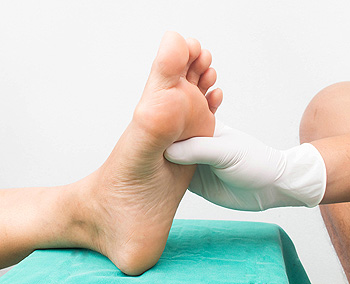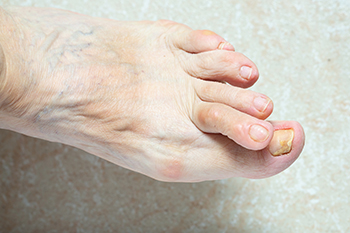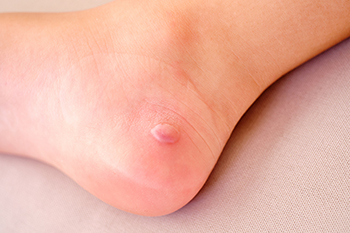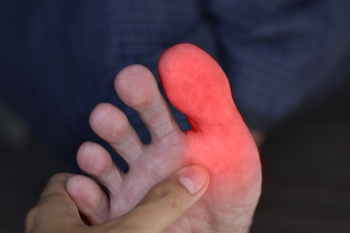Connect With Us
Blog
Items filtered by date: June 2025
Heel Pain Can Be Treated!
Protecting Your Diabetic Feet

Proper foot care is essential for individuals with diabetes, as high blood sugar can lead to poor circulation and nerve damage, called neuropathy. This can reduce sensation in the feet, making it hard to notice cuts, blisters, or infections that may worsen over time. Common symptoms include tingling, numbness, dryness, or slow-healing wounds. Feet may appear dry, cracked, or swollen, and unnoticed injuries can quickly lead to serious complications. Daily foot care is key. Wash your feet with mild soap, dry thoroughly, especially between the toes, and moisturize to prevent cracking. Wear well-fitting shoes to avoid pressure points and inspect your feet daily for changes. Trim toenails straight across to prevent ingrown nails. A podiatrist can detect early signs of complications through regular exams and provide treatment such as wound care, nail trimming, orthotics, or footwear recommendations. For ongoing support, it is suggested that you make an appointment with a podiatrist for evaluation and treatment.
Diabetic foot care is important in preventing foot ailments such as ulcers. If you are suffering from diabetes or have any other concerns about your feet, contact one of our doctors from New Jersey and New York. Our doctors can provide the care you need to keep you pain-free and on your feet.
Diabetic Foot Care
Diabetes affects millions of people every year. The condition can damage blood vessels in many parts of the body, especially the feet. Because of this, taking care of your feet is essential if you have diabetes, and having a podiatrist help monitor your foot health is highly recommended.
The Importance of Caring for Your Feet
- Routinely inspect your feet for bruises or sores.
- Wear socks that fit your feet comfortably.
- Wear comfortable shoes that provide adequate support.
Patients with diabetes should have their doctor monitor their blood levels, as blood sugar levels play such a huge role in diabetic care. Monitoring these levels on a regular basis is highly advised.
It is always best to inform your healthcare professional of any concerns you may have regarding your feet, especially for diabetic patients. Early treatment and routine foot examinations are keys to maintaining proper health, especially because severe complications can arise if proper treatment is not applied.
If you have any questions, please feel free to contact our offices located in Little Silver, NJ and New York, NY . We offer the newest diagnostic and treatment technologies for all your foot care needs.
Relieving Hammertoe Discomfort

Hammertoe causes one or more toes to bend downward at the middle joint, often due to muscle imbalance or years of wearing tight or narrow shoes. This condition can lead to pain, stiffness, and difficulty in finding comfortable footwear. Early care focuses on relieving pressure and improving toe alignment. Switching to shoes with a deep, wide toe box can reduce friction and prevent further irritation. Toe cushions or splints may help straighten the toe and ease discomfort. Gentle stretching exercises can improve flexibility and reduce stiffness. If the toe becomes rigid or painful with movement, medical treatment may be needed. Options include custom orthotics, anti-inflammatory care, or surgery, in more severe cases. If you are experiencing persistent pain or difficulty with footwear, it is suggested that you see a podiatrist for a diagnosis and treatment plan tailored to your condition.
Hammertoe
Hammertoes can be a painful condition to live with. For more information, contact one of our doctors from New Jersey and New York. Our doctors will answer any of your foot- and ankle-related questions.
Hammertoe is a foot deformity that affects the joints of the second, third, fourth, or fifth toes of your feet. It is a painful foot condition in which these toes curl and arch up, which can often lead to pain when wearing footwear.
Symptoms
- Pain in the affected toes
- Development of corns or calluses due to friction
- Inflammation
- Redness
- Contracture of the toes
Causes
Genetics – People who are genetically predisposed to hammertoe are often more susceptible
Arthritis – Because arthritis affects the joints in your toes, further deformities stemming from arthritis can occur
Trauma – Direct trauma to the toes could potentially lead to hammertoe
Ill-fitting shoes – Undue pressure on the front of the toes from ill-fitting shoes can potentially lead to the development of hammertoe
Treatment
Orthotics – Custom made inserts can be used to help relieve pressure placed on the toes and therefore relieve some of the pain associated with it
Medications – Oral medications such as anti-inflammatories or NSAIDs could be used to treat the pain and inflammation hammertoes causes. Injections of corticosteroids are also sometimes used
Surgery – In more severe cases where the hammertoes have become more rigid, foot surgery is a potential option
If you have any questions, please feel free to contact our offices located in Little Silver, NJ and New York, NY . We offer the newest diagnostic and treatment technologies for all your foot care needs.
Causes of and Caring for Blisters

Blisters on the feet often form from friction, usually when skin rubs against tight or poorly fitted shoes. This repeated pressure separates layers of skin, allowing fluid to collect. Blisters can also appear due to burns, cold exposure, allergic reactions, or infections. On the feet, these fluid-filled pockets can become painful, especially when walking. Popping a blister yourself is not recommended, as breaking the skin increases the risk of infection. People with diabetes or circulation issues should be especially cautious, as blisters can become infected more easily. Signs of infection include redness, swelling, warmth, or pus. A podiatrist can evaluate the blister, relieve pressure safely, and recommend treatment to reduce pain and protect the surrounding skin. If you have developed a problematic blister on your foot, it is suggested that you schedule an appointment with a podiatrist for an exam and treatment options.
Blisters are prone to making everyday activities extremely uncomfortable. If your feet are hurting, contact one of our doctors of New Jersey and New York. Our doctors can provide the care you need to keep you pain-free and on your feet.
Foot Blisters
Foot blisters develop as a result of constantly wearing tight or ill-fitting footwear. This happens due to the constant rubbing from the shoe, which can often lead to pain.
What Are Foot Blisters?
A foot blister is a small fluid-filled pocket that forms on the upper-most layer of the skin. Blisters are filled with clear fluid and can lead to blood drainage or pus if the area becomes infected.
How Do Blisters Form?
Blisters on the feet are often the result of constant friction of skin and material, usually by shoe rubbing. Walking in sandals, boots, or shoes that don’t fit properly for long periods of time can result in a blister. Having consistent foot moisture and humidity can easily lead to blister formation.
Prevention & Treatment
It is important to properly care for the affected area in order to prevent infection and ease the pain. Do not lance the blister and use a Band-Aid to provide pain relief. Also, be sure to keep your feet dry and wear proper fitting shoes. If you see blood or pus in a blister, seek assistance from a podiatrist.
If you have any questions, please feel free to contact our offices located in Little Silver, NJ and New York, NY . We offer the newest diagnostic and treatment technologies for all your foot care needs.
Complex Regional Pain Syndrome of the Big Toe

Complex regional pain syndrome, or CRPS, is a chronic pain condition that can develop after an injury, surgery, or trauma, even if the initial event seems minor. When CRPS affects only the big toe, it can cause intense, persistent pain that is often out of proportion to the original injury. Other symptoms include swelling, temperature changes, skin color changes, and increased sensitivity to touch or pressure. In some cases, the toe may become stiff or difficult to move. Although CRPS is more commonly seen in the hand or foot as a whole, it can also be localized to a single toe. Treatment includes medication, targeted exercise, nerve blocks, and desensitization techniques aimed at restoring function and relieving pain. If you are experiencing unexplained or prolonged pain in your big toe following an injury or procedure, it is suggested that you see a podiatrist for a diagnosis and appropriate treatment.
Toe pain can disrupt your daily activities. If you have any concerns, contact one of our doctors of New Jersey and New York. Our doctors can provide the care you need to keep you pain-free and on your feet.
What Causes Toe Pain?
Most severe toe pain is caused due to a sports injury, trauma from dropping something heavy on the toe, or bumping into something rigid. Other problems can develop over time for various reasons.
Toe pain can be caused by one or more ailments. The most common include:
- Trauma
- Sports injury
- Wearing shoes that are too tight
- Arthritis
- Gout
- Corns and calluses
- Hammertoe
- Bunions
- Blisters
- Ingrown toenails
- Sprains
- Fractures (broken bones)
- Dislocations
When to See a Podiatrist
- Severe pain
- Persistent pain that lasts more than a week
- Signs of infection
- Continued swelling
- Pain that prevents walking
Diagnosis
In many cases the cause of toe pain is obvious, but in others, a podiatrist may want to use more advanced methods to determine the problem. These can range from simple visual inspections and sensation tests to X-rays and MRI scans. Prior medical history, family medical history, and any recent physical traumatic events will all be taken into consideration for a proper diagnosis.
Treatment
Treatments for toe pain and injuries vary and may include shoe inserts, padding, taping, medicines, injections, and in some cases, surgery. If you believe that you have broken a toe, please see a podiatrist as soon as possible.
If you have any questions please contact our offices located in Little Silver, NJ and New York, NY . We offer the newest diagnostic and treatment technologies for all your foot and ankle needs.

